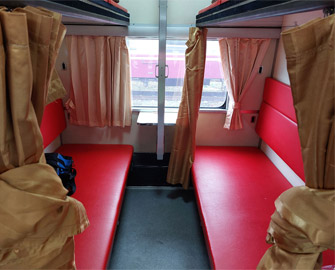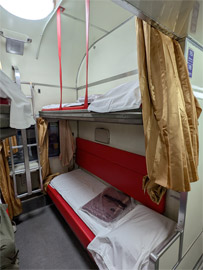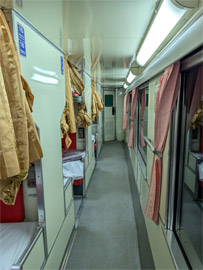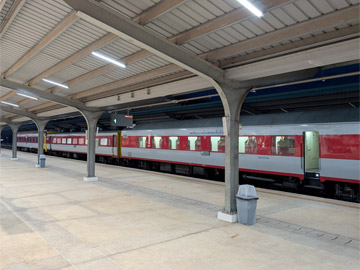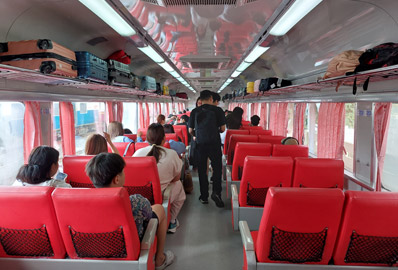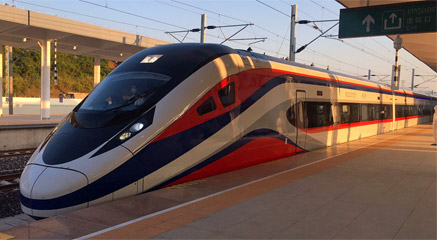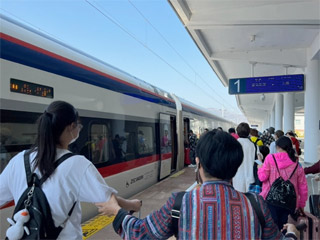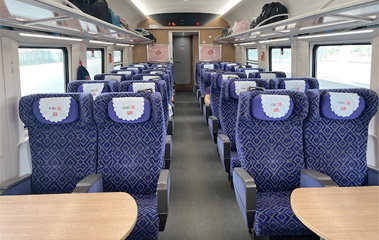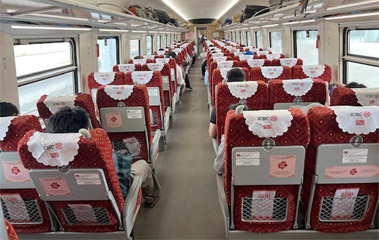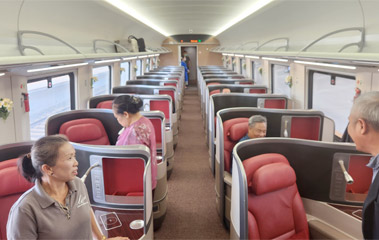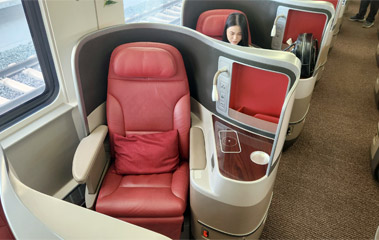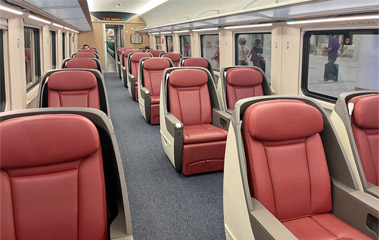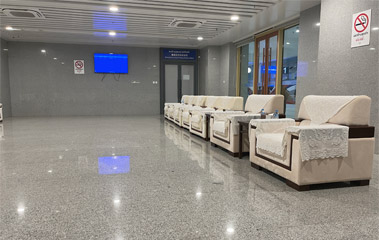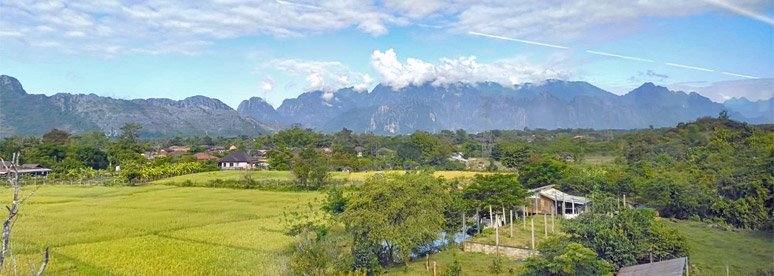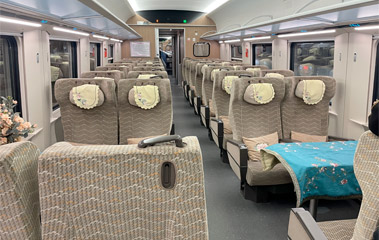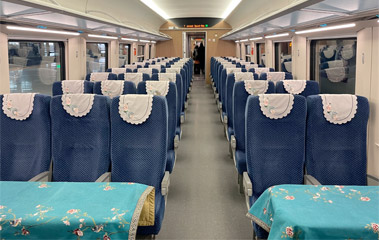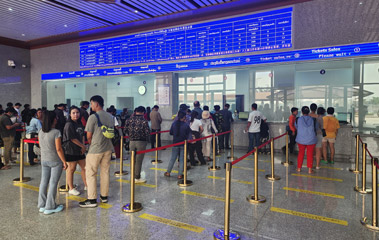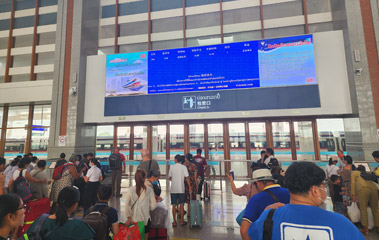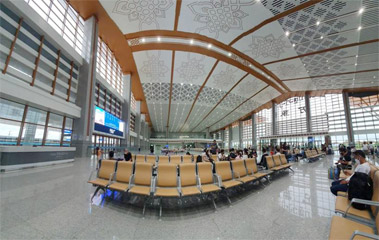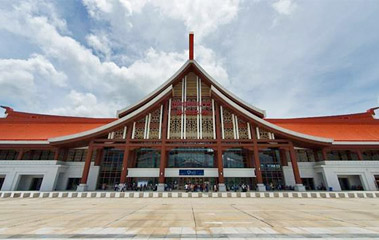Overland to Vientiane & Luang Prabang
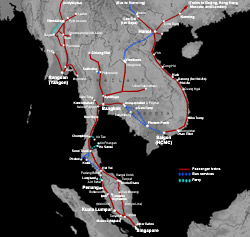 |
This page explains how to travel by bus or train between Laos & neighbouring countries, and within Laos between Vientiane & Luang Prabang. Until recently, Laos had no railways at all, but it now has two: In 2009, a metre-gauge line opened from Nong Khai in Thailand to Thanaleng in Laos, extended to a new station at Vientiane in 2024, there's now a Bangkok-Vientiane sleeper train. The standard-gauge Laos China Railway (LCR) opened in 2021 linking Vientiane, Luang Prabang and the Chinese border with connections to/from Kunming. See map of train routes in Southeast Asia.
Information on this page
![]() Vientiane to Luang Prabang by
train, bus or
boat
Vientiane to Luang Prabang by
train, bus or
boat
![]() Hanoi to Vientiane or Luang Prabang by bus
Hanoi to Vientiane or Luang Prabang by bus
![]() Beijing - Kunming -
Luang Prabang - Vientiane by train
Beijing - Kunming -
Luang Prabang - Vientiane by train
![]() Europe to Laos by Trans-Siberian Railway
Europe to Laos by Trans-Siberian Railway
![]() Hotels & accommodation in Laos
Hotels & accommodation in Laos
Information on other pages
![]() Bangkok - Kuala Lumpur - Singapore by train
Bangkok - Kuala Lumpur - Singapore by train
Useful country information
Vientiane to Luang Prabang
The jewel in Laos' crown is Luang Prabang, a city of French and Buddhist colonial buildings next to a river and nestled in mountains. You can travel from Vientiane to Luang Prabang by bus, river boat or (since December 2021) by 160 km/h air-conditioned train.
Option 1, Vientiane to Luang Prabang by train
Since 2021, Vientiane & Luang Prabang are linked by fast air-con train in as little as 2 hours, see the Kunming-Luang Prabang-Vientiane section.
Option 2, Vientiane to Luang Prabang by minivan
Vientiane to Luang Prabang by Chitpasong air-conditioned minivan takes 6h, with departures at 08:00, 11:00, 13: 16:00.
Various companies also run buses, both air-con VIP daytime buses taking 10 hours, and overnight sleeper buses of varying quality.
Fare: 280,000 Kip by minivan.
How to buy tickets: Buy tickets at 12go.asia.
Option 3, Vientiane to Luang Prabang by boat
Vientiane - Luang Prabang by 6-seater river speedboat, 11 hours, morning departures, about $20 one-way. One seat61 correspondent has said he did not feel safe on the speedboat. No online booking, ask locally, for example at your hotel.
Bangkok to Vientiane
It's easy to travel from Bangkok to Vientiane by train. Since 19 July 2024 there's a daily direct sleeper train with air-conditioned 2nd class sleepers, air-con 2nd class seats & 3rd class seats. Or you can take a high-quality Chinese-built sleeper train with modern 1st class & 2nd class sleepers from Bangkok to Nong Khai then an onward train from Nong Khai to Vientiane.
Until 2024, trains from Thailand only went as far as Thanaleng, 13 km short of Vientiane. On 19 July 2024 a direct Bangkok-Vientiane sleeper train started and trains now run to Vientiane Khamsavath station, also known as Vientiane-Tai, 7 km from downtown, see Vientiane Khamsavath location map. A taxi to the station from downtown Vientiane should cost 80,000-100,000 kip ($4-$5) on the meter, or ordered through a hotel fixed-price 300,000 kip ($14) at 2025 prices.
Train times northbound
Train times southbound
Notes for timetable
Train 133/134 is the easiest option, a direct train between Bangkok & Vientiane with one air-conditioned 2nd class sleeping-car, one air-conditioned 2nd class seats car & two non-air-con 3rd class seats cars. See border procedures.
Train 25/26 is a high-quality Chinese-built sleeper train with 1st class sleepers, 2nd class sleepers (air-con) & restaurant car.
Train 76/77 = Diesel Railcar express with 2nd class air-conditioned seats. Southbound, if you prefer to travel by day you can stay overnight in Nong Khai and take train 76 to Bangkok. Northbound, train 77 is not recommended as it runs overnight but has no sleepers, only seats.
Train 147/148 = 2nd class air-con & 3rd class non-air-con.
1 = 1st class sleeper. S = 2nd class sleeper (air-con). s = 2nd class sleeper (non-air-con). 2 = 2nd class seats. 3 = 3rd class seats. R = Restaurant car.
How much does it cost?
£1 = 44 baht. €1 = 35 baht. $1 = 33 baht.
Child fares: Children aged 0 to 3 and less than 100cm in height travel free, children aged 4 to 11 and under 150cm travel at half fare, children 12 years old and upwards (or over 150cm high) pay full fare. About these fares: The sleeper fares shown here are for a lower bunk, an upper bunk is 50-100 baht less in 2nd class. Non-air-con 2nd class sleepers (available on a few trains) cost 160-200 baht less than the air-con variety.
How to buy tickets
Option 1, book at reliable agency 12go.asia.
Use these links to book direct train 133/134: Book Bangkok > Vientiane. Book Vientiane > Bangkok
You can also book the trains between Bangkok & Nong Khai and Nong Khai & Vientiane this way.
You can book in multiple currencies, overseas credit cards accepted, you board with an e-ticket on your mobile.
Option 2, book at reliable agency www.baolau.com.
Use these links to book direct train 133/134: Book Bangkok > Vientiane. Book Vientiane > Bangkok
You can also book the trains between Bangkok & Nong Khai and Nong Khai & Vientiane this way.
You can book in multiple currencies, overseas credit cards accepted, you board with an e-ticket on your mobile.
Option 3, book on the SRT website
You can also book at the State Railways of Thailand website www.dticket.railway.co.th, only in Thai baht.
Exit fee: There's a 10,000 kip or 40 baht exit fee to pay on leaving Laos.
Border procedures
Northbound: Train 133 from Bangkok to Nong Khai stops at Nong Khai for 40 minutes. All passengers must get off and go through Thai exit passport checks on the platform. You then re-board the through coaches to Vientiane, which by then will have been drawn forward to the far end of the platform. On arrival in Vientiane you get off and go through Laos passport control. If you don't already have a Laos e-visa (e-visas can be used at this border crossing from February 2025), you can buy a Laos visa-on-arrival, have a passport photo and USD 40 in cash with you. Feedback appreciated.
Southbound: You should arrive at Vientiane Khamsavath station 45-60 minutes before departure. Laos departure formalities are carried out at Vientiane station before boarding, including a passport & exit card check, you must pay a 10,000 kip (less than $0.50) Laos exit tax, in cash. On arrival at Nong Khai, the train stops at one end of the platform. All passengers must get off with their bags and pass through Thai immigration & passport checks. Meanwhile, the train is searched and pulls forward to the other end of the platform. You then re-board the train for Bangkok.
What's the train like?
Train 133/134 Bangkok-Vientiane has one air-conditioned 2nd class sleeping-car, shown below. It's a former Japanese Railways car with a side corridor off which open door-less bays of 4 berths, 2 upper, 2 lower. Bedding is provided and each berth has curtains for privacy. There is one air-conditioned 2nd class seats car (below right) & two non-air-con 3rd class seats cars.
2nd class air-con sleeper from Bangkok to Vientiane. Bays of 4 berths open off a side corridor, with curtains for privacy. Photo above left courtesy of Suzanne McGowan, above centre & right courtesy of Alan Woosnam.
Nong Khai to Vientiane using local transport
Nong Khai is just a few kilometres from the Friendship Bridge over the Mekong River into Laos. If the twice-daily trains don't suit you, you can travel between Nong Khai station and Vientiane at any time through the day, like this:
(1) Take a local tuk-tuk taxi from Nong Khai railway station to the Nong Khai bus station.
(2) A shuttle bus runs from the bus station across the Friendship Bridge to Laos every 20 minutes throughout the day, fare about 30 baht. It stops at Thai immigration 5 minutes after leaving the bus station then crosses the Friendship Bridge to arrive at Lao customs & immigration some 10 minutes later (a 30-day visa on arrival available for Laos at this border point).
(3) You now remove your luggage from the bus luggage hold and go through Lao customs. Take another tuk-tuk to your chosen hotel. When travelling southbound, leave central Vientiane at least 3 hours before your train leaves Nong Khai for Bangkok to allow time for border formalities and the various bus/taxi journeys.
Hanoi to Vientiane & Luang Prabang
You can take a bus from Hanoi to Vientiane or Luang Prabang, but bear in mind that it's a 20 hour ride to Vientiane or 23 hours to Luang Prabang - a night and a day. A few years ago, reports from travellers said that this was a rough ride on poor roads though mountainous areas, but offset by spectacular scenery so well worth doing. More recent reports say that things have improved, with better roads and there's a more modern bus with sleeper bunk on the Hanoi-Vientiane route, at least on three days a week. An older bus, still with sleeper bunks, operates on the other days. A daily bus operates Hanoi to Luang Prabang. There are also buses from Hue and Danang to the border, for onward buses to Vientiane.
The modern bus has sleeper bunks & toilet. The older bus also has sleeper bunks but no on-board toilet. Are the bunks long enough to sleep in? See the travellers' reports below! The bus operates via the Nam Phao - Cau Treo border point. If you use this route, feedback or photos would be appreciated!
How much does it cost?
How to buy tickets
You can buy tickets online for these buses in either direction at 12go.com, a reliable online ticketing agency.
The bus company itself has no website, let alone online ticket sales, so either pre-book through 12go.com or buy tickets at the bus station or via your guesthouse or a local travel agency when you get to Hanoi or Vientiane. In Hanoi, you can buy tickets for this bus at the Nuoc Ngam (Southern) Bus Station on Giai Phong Street. The bus ticket also shows a 'main office' in Hanoi as 70B Hoang Hoa Tam, call 04 37222514. The ticket office phone number in Vientiane is (020) 98112233, and the RD Guesthouse in Vientiane can also arrange tickets. Or simply ask for a bus ticket at any travel agency or guesthouse in Vientiane of Hanoi. Feedback from travellers about this bus service would be very welcome!
Visas for Laos: Check which border crossing your bus will use, and check that the crossing offers visa on arrival. Some border points don't.
Traveller's reports
Traveller Jonny Steph reports: "You can arrange a bus to Vientiane from Hanoi through most hostels, hotels and travel agencies in Hanoi. The bus leaves every night and costs around $30US per person. We were greeted in our hostel at exactly 5pm by a man on a moped. He came in, asked ‘Laos?’ and told us to follow him. There was a group of about 6 Japanese guys standing outside and we all followed him as he drove off on his moped. We arrived outside a travel agent/hotel a few blocks away, nearer the motorway and were told to wait. About 10-15 mins later a mini bus arrived and we were told to get in. We picked some more people up and made our way to the bus station.
Once at the bus station we gave our passports and were each issued a ticket. We were then told to go wait at our respective busses, some going to Luang Prabang and some to Vientiane. The Hanoi bus station is odd to Westerners but seems the norm in SE Asia. Locals sitting on their plastic stools in front of the bus all carrying more possessions than a house could hold. We waited a long while before they let people on the bus, with the driver and his assistants leaving for quite some time. All the foreigners were put on the bus first. This included us, 2 English guys, and about 8 Japanese guys. We were put in the back of the bus.
The bunks are not very comfortable, they do the job but don’t be expecting any kind of luxury. Battered leather ‘beds’ with little to no space to stretch out fully (all the Westerners were hugging their knees). There isn’t much space to bring bags on the bus, you can put it by your feet but this means you are not able to stretch out fully. Our seats were above the engine so it got very hot, not unbearable, just uncomfortable. This is just the luck of the draw though. You had to take your shoes off before you entered the bus, and were given a plastic bag for your shoes. I imagined this would be the norm in Laos, but as yet no other bus has had this requirement.
The bus was scheduled to leave at about 7.25pm but did not leave until after 8. The journey was very bumpy in parts but in whole was ok. Our bus stopped an awful lot. I don’t know if this is the norm or just our driver wanting to stop. We picked up a few people on the roadsides who were given mattresses on the floor in between the other beds. There is a toilet at the back (where all the foreigners were sitting) it’s fine, like a plane toilet. Remember to Bring Your Own Toilet Roll!
We arrived at the border about 6. There is a café there where you
can wait for the border to open at 7. All the border staff on the
Vietnam side were eating breakfast there. Once 7am rolled round you
make your way on foot to the border, you can leave your bags in the
bus. It cost $1 to ‘Stamp out’ of Vietnam. Once you pass immigration
you then walk about 1km to the Laos border. As you go in there is a
window for ‘Visa on Entry’ then a price list for each country. If you do not have the cash then there is an ATM in
the building. You also have to pay a $1 ‘stamp fee’. Once through
immigration a friendly guard checked our Visas and sent us on our
way. You get back on the bus and then on to Vientiane.
We arrived in Vientiane about 3pm. From then a TukTuk appeared and
took everyone into town for $2.5 a person which seemed reasonable
enough as there was not much other option! The tuk tuk was fine, the
guy drove around the bus station until it was full so he made a fair
amount off the journey. All in all it isn’t a bad journey and you
get some great views of Vietnam and Laos and it is quite the
experience to walk through the borders. The roads in Laos are all
very new and smooth. I am not sure what all the busses are like but
ours was very busy, again mostly with Vietnamese and Lao. Most
foreigners seem to opt for the Hanoi – Luang Prabang bus - which did
look slightly more comfortable.
Traveller Simon Philips reports: "We took the 24 hour sleeper bus to Laos; your info was spot on. We got a ticket from the 'Little Hanoi Hostel', which we'd recommend - fantastic service, and a great place to stay too. We were picked up along with half the western world in a packed minibus which ferried us all to the bus station in the south of town. When we got to the bus, it was as expected - we were on the modern one, and though not spacious it was sufficient, with the toilet working fine (and not too smelly). The bus driver's assistant was a little aggressive, shouting at people to tell them where to sit - in theory it is allocated based on your ticket, but since you've only been given your ticket seconds earlier on arrival at the bus station, it isn't all that helpful. We ended up sitting where we wanted, but others were made to move, after nearly having a fight with him. One piece of advice - it seems the shorter seats are the 'A' row of seats on the left, and the set of three in a sort of bed arrangement together right at the back. Long legged travellers beware! We stopped at the border at dawn, and when it opened walked the (longer than expected) kilometre or so to the Laos side. The bus made it to the Southern Bus Station in Vientiane around 5pm, 2 hours early - to much delight! We'd definitely do it again rather than flying."
Traveller Christine reports: "I just travelled from Hanoi (where I live) to Vientiane by bus, and found the trip quite pleasant. The drivers and assistants were friendly and drove relatively carefully with not too much horn honking. There is a bathroom on the bus and a stop for dinner. I think the bunks are not really long enough for a westerner of 6 feet to stretch out totally but one has enough width to move around and bend the knees. There were many tall guys on my bus and no one was complaining! The road is not nearly as treacherous as others describe. It's quite wide and smooth actually. The scenery is indeed very beautiful once in Lao. There is a $1 "stamp fee" when leaving Vietnam and a $2 "stamp fee" when entering Lao. The bus assistant collected all the passports and money for these fees the night before and took them to the officials for those who already had visas. Foreigners without visas walked their own passports through the process. One can also take this bus from Vientiane to Hanoi. It also leaves at 19:00 and then arrives at the border at about 2am and just sits there waiting for the border to open at 7am. Tickets can be booked in Vientiane at the RD Guesthouse for $34. Be aware that the nice bus with the bathroom only runs Tuesday, Thursday & Saturday. On the other days an older bus with no bathroom runs at the same price. Once can get a cheaper price by calling the bus company directly but booking at the guesthouse is more convenient.
Traveller Paul Wiesbauer reports: "The journey was very pleasant, even in the older bus! The information about the "modern" and "older" bus on your page is correct, even if the ticket seller tells something different! At the Nam Phao - Cau Treo border you have to pay exit stamp fee in Laos (10000 KIP or 2 USD) and entry stamp fee in Vietnam (200000 VND or 1 USD). On the Lao side there is a bank with the opportunity so to change money (KIP/USD/VND) but at semi good rates! The stamp fees are cheaper if paid in VND and KIP."
Round-the-world traveller James Weld reports: " I just did the bus journey from Hanoi to Vientiane by bus. It costs $15 on the cheap bus which was adequate. It took 20 hrs starting at 7 pm and getting to the border crossing about 8 am. It took 2 hours to get out of customs and we got into Vientiane at 4 pm. In my opinion it was worth the overnight journey which wasn't great (it was hard to sleep on the packed bus) then the journey in to Laos was spectacular, great scenery well worth the over night bus journey. When you get to the bus depot (which is 2kms out of town), a Tuk tuk should not cost more than 10,000 kip per person into the heart of town. My advice is, get the bus, don’t fly. Far cheaper, and you get to see some great views."
Beijing & Kunming to Vientiane
A new Chinese-built standard-gauge line called the Laos-China Railway (LCR) opened on 3 December 2021, linking Vientiane, Luang Prabang and the Chinese border at Boten. International trains started on 13 April 2023, linking Vientiane & Luang Prabang with Kunming in China. Trains operate at up to 160 km/h in Laos between Vientiane, Luang Prabang & Boten, then at up to 200 km/h in China between Boten and Kunming. More about the China-Laos Railway on Wikipedia. It's the fastest & most comfortable way to travel between Vientiane and Luang Prabang, although buying a ticket can sometimes take longer than the train ride!
Note that visa-on-arrival for Laos is not available when arriving from China by train at Mo Han. You can buy an e-visa at laoevisa.gov.la.
Laos-China Railway (LCR) from 7 July 2025
Notes for timetable
You can check these times at the Laos Railway's Facebook page, www.facebook.com/LaosChinaRailway.
All times are local time. Remember the 1 hour the time difference between Laos & China, Laos = GMT+7, China = GMT+8.
If you have more information or photos, please get in touch!
* = Train C97/C98 is temporarily suspended as from July 2025, but may resume at some point
B = Business class. 1 = 1st class. 2 = 2nd class. S = Soft sleeper (day mode). H = Hard class seat.
C81-C98 = Express trains. Business class, 1st class, 2nd class (Business class = premium 1st class).
D83-D88 = International express train, 1st & 2nd class.
K11, K12 = ordinary train with soft sleepers (used in day mode as 4-seat compartments) and hard class seats.
Vientiane station is some 14 km from central Vientiane, about 30 minutes by taxi for around $15, see location map.
Luang Prabang station is some 12 km from central Luang Prabang, about 25 minutes by taxi, see location map.
For trains between Beijing & Kunming, see the Train travel in China page.
How much does it cost?
$1 = 20,500 kip. £1 = 26,000 kip.
How to buy tickets
-
Option 1, buy at 12go.asia - easy
12go.asia is a reliable Asian train, bus & ferry booking agency.
They can arrange tickets between Vientiane & Luang Prabang or between Laos & China, in either direction.
You will need to upload a scan of each passenger's passport, this is normal and required for them to obtain tickets for you. Bear in mind that they can only confirm your booking when sales open 2 or 3 days before departure.
-
Option 2, buy at Bookaway.com - also easy
Bookaway.com is another reliable train, bus & ferry booking agency.
They can arrange tickets between Vientiane & Luang Prabang or between Laos & China, in either direction. Bear in mind that they can only confirm your booking when sales open 2 or 3 days before departure.
-
Option 3, use the new LCR app - now possible
The Laos China Railway launched an app in March 2023. You can buy tickets in the app, originally you needed to have a Laos SIM card in your phone, but it will now let you set up an account with an email address and pay with a Visa credit card.
-
Option 4, buy at www.lcrc.ltd - not yet possible.
The official Laos China Railway website exists, but no sign of anything useful on it, let alone online booking. By all means have a look-see, it may change in coming months.
-
Option 5, buy at the station - a right royal pain in the neck
You should do this a day or two in advance, booking opens 7 days ahead (extended from 4 days in July 2025) and trains fill up quickly. Remember that the stations are some kilometres out of town, the round trip in a taxi may cost more than the ticket! You'll need all passengers' passports. It can be busy, be prepared to queue up and allow plenty of time - ideally, get there 30 minutes before the ticket office opens.
Vientiane ticket office opening hours are 07:00-11:00, 14:00-17:00, 18:30-20:00. You must pay in cash, in kip.
-
Option 6, buy from the Vientiane or Luang Prabang city centre offices - saves the taxi ride, but also a pain in the neck
In Vientiane there's a small city centre office next to the bus station and morning market, between some jeweller’s shops in a passageway marked Laos-China Railway. However, they don't accept cash or credit cards, you need a Lao bank account with the Q code app, for example One pay. You might find a Lao local who can buy for you using their app, then you can reimburse them with cash. Further feedback appreciated.
In Luang Prabang there's a similar office, Laos-China Railway ticket office V4PJ+73X, Luang Prabang, see location on Google Maps. It's open 10:00-12:00 & 12:30-15:30. It suffers the same purchasing problems as the Vientiane office.
-
Option 6, ask your hotel or guesthouse - often the easiest option!
Ask your hotel or guesthouse if they can procure tickets for you. Give them a 2nd choice train in case your first choice is full. Remember they can only book 2 days ahead. The way the LCR are handling ticket sales, this is probably by far the easiest option, and cheaper than a round-trip taxi to the station.
What are the C trains like?
Laos trains C81 to C84 are streamlined air-conditioned 8-car electric unit built in China, a version of the Chinese CR200J, maximum service speed 160 km/h. 1 x 1st class car, 1 catering car, 6 x 2nd class cars, see the photos below. Train K11/K12 is a 2nd class only ordinary train, maximum service speed 120 km/h.
The Vientiane-Luang Prabang 'C' category fast train. Courtesy of H.M. Ambassador to Laos, John Pearson.
Newer-style business class on train C82. Photos courtesy of Wayne Humphreys.
Scenery from the train. Courtesy of Douglas Tam.
What are the D trains like?
Trains D87 & D88 between Kunming & Vientiane are green-liveried Chinese high-speed trains with 1st & 2nd class and cafe car. Although the same train type (CR200J) as the Laos-owned C trains, these Chinese-owned D trains don't have any business class seats.
Train D87 at Kunming (on the right). Courtesy of B. John Ovink.
What are the stations like?
These are new stations, built for the new railway and located a little way out of town. Vientiane station is 14 km from central Vientiane, about 30 minutes by taxi, see location map. Luang Prabang station is 12 km from central Luang Prabang, about 25 minutes by taxi, see location map.
There is a security check to enter the station, knives and so on (even small Swiss army knives) will be confiscated, as will any alcohol, or hand gel/insect repellent/deodorant/hand sanitiser if they are marked as flammable (although latest reports suggest they may have lightened up a bit). There is then a ticket check onto the platform to board the train, boarding usually takes place from 30 minutes before departure until 5 minutes before.
Inside the station after the security check there are toilets, seats & water, a small sandwich shop, cafe and a Dairy Queen ice cream shop.
Vientiane station. Courtesy of Douglas Tam. Photos below courtesy of Alan Seah.
At Vientiane ticket office (above left), an electronic display shows availability in each class on each of that day's trains. It switches between local script and English. Above right, passengers wait until boarding is called. Photos courtesy of @Travel Lexx.
Travellers' reports
Traveller Kris Ignaciuk reports (2025): "I bought my tickets about two weeks in advance through 12go Asia; everything worked as promised. If you are travelling on international routes with a 12go booking, don't use the main entrance, use the entrance to the right (where tickets are sold) to exchange 12go's QR codes for hard-copy tickets. The train station is a majestic, very clean building. Baggage is x-rayed before entry (but shaving gels, shampoos, and sanitizers in large packs all went through without problem). The building has a couple of basic cafés and shops. There's a basic bar on the train, you'll need a translator app plus WeChat or Alipay to pay). You need to exit the train twice (with your luggage) for passport checks, once on the Laos side and once on the Chinese side. Have tickets and passports handy. On arrival in Kunming, tickets are required to exit the station."
Traveller B.John Ovink explains the boarding process in Kunming (2025): "Enter the station at the West entrance on the second floor. Inside the station go directly to the special entrance for international Laos passengers on the right. Go through security, you just need your passport at this point. The guard will direct you to go to gate 17 B. Since you enter near gate 1, that’s about a 5 minute walk.
What they don’t tell you (and that may just be due to the lack of Chinese on my part or the limited English of the station guard), is that you first need to go to the information booth in the centre of the hallway between gates 14A and 14B to exchange your e-ticket for a paper ticket. The staff need your e-ticket and passport.
You then go to the reasonably comfortable chairs and wait for the ticket gate to open, about 18 minutes before departure. If you are a foreigner, you enter through the right-hand gate. There's no rush because checking in goes really fast. I also advise to not come too early because there is an annoying loudspeaker constantly repeating something in Chinese, probably something about paper tickets. Remember that you can't get a visa at the border, you need to get an e-visa before you board the train.
Traveller Tim van den Bogaard reports: "Security at the stations is apparently outsourced to a Chinese company and it's definitely not funny. Every item in your luggage that has a flammable icon will be taken from you. This also means deodorants and hairsprays. There were not a lot of westerners but every time a tuktuk full of westerners passed security they could start a drug store next door. The part from Vientiane to Vang Vieng is very scenic. The part between Vang Vieng and Luang Prabang is basically just one big tunnel with a glimpse of sunlight and spectacular mountain scenery every now and then."
Europe to Laos by Trans-Siberian Railway
Update 2026: The war in Ukraine and sanctions on Russia means there are currently no trains from western Europe to Moscow, Moscow-Beijing Trans-Siberian trains also remain suspended. But for the record, here's how you could reach Laos overland before the war and pre-pandemic:
If you have the time (we're talking 14 days), it's possible to reach Laos overland from London or anywhere else in Europe, by train from London to Moscow, then the Trans-Siberian Railway from Moscow to Beijing.
When Covid recedes and cross-border services begin, you will be able to take a Beijing-Kunming train then the new fast rail link from Kunming via Boten to Luang Prabang & Vientiane, see the China-Vientiane section above.
Alternatively, you can take the twice-weekly Beijing-Hanoi soft sleeper train or a daily Beijing-Nanning train and the daily Nanning-Hanoi sleeper (both suspended due to Covid). From Hanoi, you have a choice of routes to Laos. The direct route involves a long and arduous 24-hour bus journey from Hanoi to Vientiane (see the section below). The more comfortable and civilised option means going the long way round, taking several days, by train from Hanoi to Saigon, then bus from Saigon to Phnom Penh & Phnom Penh to Bangkok, then train from Bangkok to Nong Khai for Vientiane.
Hotels & accommodation
Travel insurance & other tips
Always take out travel insurance
Never travel overseas without travel insurance from a reliable insurer, with at least £1m or preferably £5m medical cover. It should also cover cancellation and loss of cash and belongings, up to a sensible limit. An annual multi-trip policy is usually cheaper than several single-trip policies even for just 2 or 3 trips a year, I have an annual policy with Staysure.co.uk myself. Here are some suggested insurers. Seat61 gets a small commission if you buy through these links.
![]() www.staysure.co.uk
offers enhanced Covid-19 protection & gets 4.7 out of 5 on
Trustpilot.
www.staysure.co.uk
offers enhanced Covid-19 protection & gets 4.7 out of 5 on
Trustpilot.
![]() www.columbusdirect.com
is also a well-know brand.
www.columbusdirect.com
is also a well-know brand.
![]() If you live in the USA try
Travel Guard USA.
If you live in the USA try
Travel Guard USA.
Get an eSIM with mobile data package
Don't rely on WiFi, download an eSIM with a mobile data package for the country you're visiting and stay connected. Most newer mobile phones can download a virtual SIM card so you don't need to buy a physical SIM, including iPhone 11 & later, see device compatibility list. Maya.net is a reliable eSIM data retailer with a 4.5 out of 5 Trustpilot rating and a range of packages including unlimited data.
Get a Curve card for foreign travel
Most banks give you a poor exchange rate, then add a foreign transaction fee on top. A Curve MasterCard means no foreign transaction fees and gives you the mid-market exchange rate, at least up to a certain limit, £500 per month at time of writing. The money you spend on your Curve card goes straight onto one of your existing debit or credit cards.
How it works: 1. Download the Curve app for iPhone or Android. 2. Enter your details & they'll send you a Curve MasterCard - they send to the UK and most European addresses. 3. Link your existing credit & debit cards to the app, you can link up to two cards with the free version of Curve, I link my normal debit card and my normal credit card. 4. Now use the Curve MasterCard to buy things online or in person or take cash from ATMs, exactly like a normal MasterCard. Curve does the currency conversion and puts the balance in your own currency onto whichever debit or credit card is currently selected in the Curve app. You can even change your mind about which card it goes onto, within 14 days of the transaction.
I have a Curve Blue card myself, it means I can buy a coffee on a foreign station on a card without being stung by fees and lousy exchange rates, just by tapping the Curve card on their card reader. The money goes through Curve to my normal debit card and is taken directly from my account (in fact I have the Curve card set up as payment card on Apple Pay on my iPhone, so can double-click my phone, let it do Face ID then tap the reader with the phone - even easier than digging a card out). I get a little commission if you sign up to Curve, but I recommend it here because I think it's great. See details, download the app and get a Curve card, they'll give you £5 cashback through that link.
Get a VPN for safe browsing. Why you need a VPN
When you're travelling you often use free WiFi in public places which may not be secure. A VPN encrypts your connection so it's always secure, even on unsecured WiFi. It also means you can select the geographic location of the IP address you browse with, to get around geoblocking which a surprising number of websites apply. See VPNs & why you need one explained. ExpressVPN is a best buy with a 4.7 out of 5 Trustpilot ranking which I use myself - I've signed up as an ExpressVPN affiliate, and if you go with expressvpn.com using the links on this page, you should see a special deal, 3 months free with an annual subscription. I get a small commission to help support this site.
Carry an Anker powerbank
Tickets, reservations, vaccination records and Interrail or Eurail passes are often held digitally on your mobile phone, so it's vital to keep it charged. I always carry an Anker powerbank which can recharge my phone several times over if I can't get to a power outlet. Buy from Amazon.co.uk or from buy from Amazon.com.


